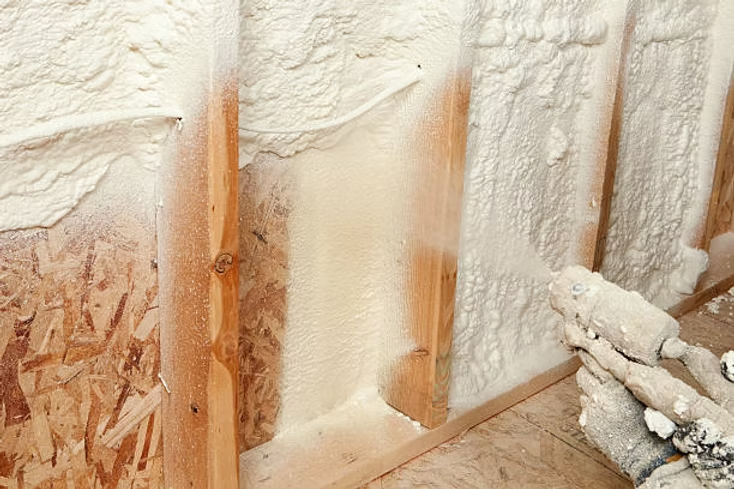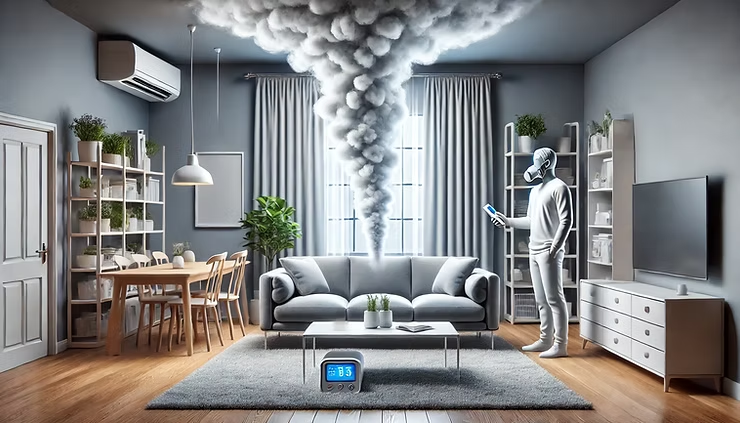The Complete Guide to Spray Foam Insulation: Benefits, Risks, and Air Quality Testing
- admin323029
- Blog

Spray foam insulation has gained popularity as an effective solution for energy efficiency, sealing gaps, and improving indoor comfort. However, concerns about off-gassing, VOC emissions, and potential exposure to chemicals like formaldehyde have raised questions about its safety. This blog post explores the benefits and drawbacks of spray foam insulation, how it affects indoor air quality, and the importance of air quality testing.
What is Spray Foam Insulation?
Spray foam insulation is a versatile material applied as a liquid that expands into a foam, creating a seamless barrier against heat loss, moisture, and air infiltration. It is commonly used in walls, attics, and crawl spaces.
Two primary types of spray foam insulation include:
- Open-cell spray foam: Lightweight and flexible, this type is effective for soundproofing and filling irregular spaces.
- Closed-cell spray foam: Dense and rigid, it offers a higher R-value (thermal resistance) and moisture resistance.
Benefits of Spray Foam Insulation
- Improved Energy Efficiency Spray foam creates an airtight seal, reducing energy consumption by keeping conditioned air inside and outdoor air out.
- Enhanced Moisture Control Closed-cell spray foam acts as a moisture barrier, preventing water damage and mold growth.
- Better Indoor Comfort By eliminating drafts and cold spots, spray foam improves overall indoor comfort.
- Noise Reduction Open-cell foam absorbs sound, making it a great choice for reducing noise transmission.
The Hidden Risks of Spray Foam Insulation
While spray foam insulation offers significant advantages, its application can introduce potential health and safety risks.
1. Off-Gassing and VOC Emissions
Off-gassing refers to the release of volatile organic compounds (VOCs) during and after spray foam application. VOCs are chemicals that evaporate into the air and can impact indoor air quality.
- Short-term effects: Eye and throat irritation, headaches, and dizziness.
- Long-term exposure: Prolonged VOC exposure may lead to respiratory problems or exacerbate conditions like asthma.
2. Formaldehyde Concerns
Some spray foam products may release formaldehyde, a known VOC and carcinogen. Even in low concentrations, formaldehyde can cause irritation and health concerns, especially for individuals with chemical sensitivities.
3. Improper Installation Risks
Poorly mixed or improperly applied spray foam can exacerbate off-gassing, leading to persistent chemical odors and elevated VOC levels.
How Spray Foam Insulation Affects Air Quality
Spray foam insulation can significantly impact your home’s indoor air quality if not handled correctly. VOCs, including formaldehyde, can linger in the air for days or even weeks after installation, depending on ventilation and curing conditions.
The Importance of Air Quality Testing
Air quality testing is a critical step in ensuring your home remains safe and free from harmful chemicals after installing spray foam insulation.
What Does Air Quality Testing Involve?
Professional air quality testing measures the concentration of VOCs, formaldehyde, and other pollutants in your home.
Why is Air Quality Testing Important?
- Identify Hazards: Detect harmful VOC levels, including formaldehyde, that may be affecting your health.
- Ensure Safety: Confirm that off-gassing has subsided to safe levels.
- Peace of Mind: Gain confidence that your indoor environment is healthy and safe for your family.
Tips for Minimizing Off-Gassing
- Choose Low-VOC ProductsSelect spray foam insulation products certified for low VOC emissions, such as those with GREENGUARD or similar certifications.
- Hire Certified ProfessionalsEnsure your insulation is installed by trained and experienced professionals who follow safety protocols.
- Ventilate During and After InstallationProper ventilation during the curing process helps disperse VOCs more quickly, reducing off-gassing risks.
- Conduct Air Quality TestingTest your home’s air quality after installation to verify that VOC and formaldehyde levels are within safe limits.
Frequently Asked Questions
Q: How long does off-gassing from spray foam insulation last? Off-gassing typically lasts 24 to 72 hours after installation. However, improper application or low-quality materials can result in prolonged emissions.
Q: Can spray foam insulation cause long-term health problems? While most health concerns occur during installation and curing, prolonged exposure to VOCs, including formaldehyde, may pose long-term risks if not addressed.
Q: How can I ensure my spray foam insulation is safe? Hire certified installers, use low-VOC products, and schedule air quality testing to confirm safe indoor conditions.
Final Thoughts
Spray foam insulation is a powerful tool for improving energy efficiency and comfort, but it’s essential to address potential risks like off-gassing, VOC emissions, and formaldehyde exposure. By choosing high-quality products, ensuring proper installation, and conducting air quality testing, you can enjoy the benefits of spray foam insulation without compromising your health.
If you’re concerned about air quality after installing spray foam insulation, contact Elite Home Inspections LLC. We specialize in VOC testing, formaldehyde testing, and other air quality assessments to help you maintain a safe and healthy home environment.
Schedule Your Air Quality Testing Today!Protect your family and ensure your home is safe. Call us at (339) 227-0388 or book online to get started.
Are you worried about the cleanliness of your space?
Let us help you! Cleaning services are our specialty, and we offer a complete range of cleaning and maintenance services. Get a free estimate!




